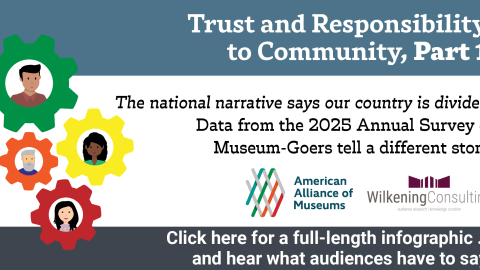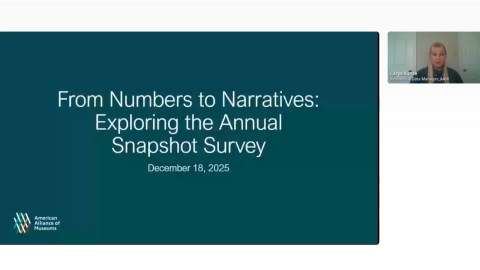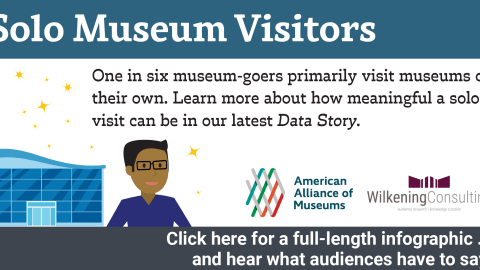This week’s guest blogger is Marie C. Malaro, a lawyer, author and retired university professor. For many years she was legal counsel for the Smithsonian Institution, and later was Director of the Graduate Program in Museum Studies at The George Washington University, where she is Professor Emerita, periodically teaching online. She is widely known for her books and many articles, as well as her 20 years of participation in the American Law Institute/American Bar Association’s annual seminar, “Legal Problems of Museum Administration.” The post originated as an email from Marie to CFM director Elizabeth Merritt, author of the article referenced in the commentary.
The weather this past winter forced me to sit down at my desk and tackle some “not urgent” matters that have been patiently waiting for my attention. On top of that pile is a copy of your article in the Jan/Feb 2010 issue of Museum that gives an overview of Museum Financial Information 2009. When I first read the article I had the urge to write you immediately with my comments, but then I reminded myself that I am supposed to be retired. So, I waffled and put the article in the “not urgent” file. Now that I look at the article again I’m inclined to forget retirement and get on my soapbox.
Your article is very good at showing how quickly things change these days and how this rapid pace has affected all aspects of our society, even throwing into question the future of museums in this country. Your focus is on what may lie ahead for our museums financially now that just about all means of support currently used by museums have been compromised by the latest financial crisis. But then after reviewing the data AAM recently compiled your advice to museums is that they may now have to run even faster than they have been in order to stay in place. This conclusion saddened me because I think we can come up with some very positive (but challenging) advice about what museums should do now, if we look back far enough.
The position the museum community now finds itself in should have been foreseen at least 30 years ago. By the early 1990’s museums were becoming more and more market oriented. The bicentennial boom of the 1970’s and early 80’s with its out- pouring of grant money for museums was over and many museums were left with new buildings and programs that were costly to sustain. The solution for many was to embrace a more entrepreneurial approach to acquiring income.
The first steps were tentative but the spirit of competition soon took hold. Museum shops were moved to center stage in museums and some even ended up in shopping malls. Exhibitions became “events” not supported by philanthropy but by corporate sponsorships which are nothing more than business arrangements with for-profits organizations. “Lending for profit” became common place and museums joined the bandwagon only to be diverted when marketers began singing the praises of “branding”. And, not surprisingly, those holding major management positions in museums began to compare themselves with managers in the for-profit world and demand similar compensation packages.
It is growing harder and harder to tell whether museums are nonprofit or for-profit organizations by the way too many operate today and just about every problem now facing museumsis due to the failure of museums to understand and adhere to their nonprofit status. Let me explain this sweeping statement.
We support a nonprofit sector in this country and afford it many privileges because we expect that sector to offer our society services and products that cannot be provided by our government sector or our for-profit sector. In other words, nonprofits are expected to stand apart from the other two sectors andputtheir special privileges (great tax advantages, government encouraged philanthropy, freedom to accept volunteer services and a public willing to volunteer,) to good use so they can provide their unique services and products tothe public.When the nonprofit sector forgets what its distinctive role is (when what it offers cannot be distinguished from what the other two sectors provide) it places in jeopardy its special privileges, and the good will of the public. This is why we see so many attempts by governments to curtail tax exemptions enjoyed by nonprofits, why true philanthropy (giving without expecting anything in return) is being replaced by “deal-making” and why there is so much confusion in the profession about what a museum is.
For more of my thoughts on this issue, I encourage readers to revisit my 1994 book “Museum Governance”.This was written for museum board members but few, I fear, have read it. I particularly recommend Part One of the book and chapters 9 and 11 in Part Two. These should flesh out what I am trying to say in this abbreviated post.
In a nutshell, there is a bright and secure future for museums if they truly commit to their nonprofit status in both word and action and demonstrate to the public that what they offer is unique and important.
P.S. I recognize that many other types of nonprofits are guilty of straying off course but nothing changes if this is the excuse used by others to do nothing.









As a long-term museum trustee and board member of a number of nonprofits over the years, I agree with Marie's broad observations, but must question the practicality of her "remedy."
I think Marie's post compresses trends of the last two decades reasonably. At Burroughs Corporation and later at Unisys, we went down that trail of "corporate partnerships" and sponsorships blurring "pure" philanthropy.
Equally, museums we partnered with seemed to get fuzzier and fuzzier about the difference between commercial branding opportunities and general operating support.
But to assert, as the post seems to, the the remedy is for museums "to truly commit to their nonprofit status in both word and action and demonstrate to the public that what they offer is unique and important" seems strangely disconnected from another reality of the last few decades.
The continuing revolution in how, as a society (and civilization), we access, use and create content, and how we think of, enjoy and leverage heritage, is challenging the foundations of what museums, libraries and archives are "in business" to do.
Indeed, answering the question of what it is that our insitutions can offer that is "unique and important" in such a marketplace sounds a bit more like a business model viability exercise than a return to nonprofit roots…
Perhaps we are now in a time when the imperative is not only to re-articulate what the continuing vital role of museum institutions might be in the next decades, but what nonprofit status means, and needs to evolve to, for that status to be meaningful and deserving of the public trust and tax-advantaged status it enjoys.
David R. Curry
Managing Principal
davidcurryAssociates
http://nonprofitgovernance.wordpress.com/
http://digitalstewardshipnow.wordpress.com/
Here. here. Both to the author and to Mr. Curry's comment. We are all looking at hybrid models now, right?
At a recent lecture at the John F. Kennedy University Museum Studies program, Dr. Robert Janes cautioned museums about giving themselves over to old-school, corporate-style metrics whose bottom-line focus that can be detrimental to real sustainability.
When I listened to Dr. Janes in his critical context, I can’t help but feel a little "chauvinistic," in the classic, patriotic sense of the word.
American museums are funded in large part by private support and the best boards consist of business leaders and Janes described this model as too often being “constraining and maladaptive.” He’s right, but it’s what we’ve got.
In America the history of museums has been so dependent on private philanthropy — from Smithson to J. Paul Getty to Sackler to Paul Allen — that it is a little tough to be so, well, damning of the well-heeled.
Frankly, the business world itself has shifted, following the new trends toward corporate responsibility, triple bottom line and systems thinking. We are all in this together.
Moreover, with the growth of professionalism in philanthropy, there is a new kind of nonprofit professional rising up through the ranks of these philanthropic entities.
Program officers are changing the world. And new, young dynamic foundation directors and presidents are playing a very provocative role in the development of museums and the arts in the United States.
Foundations are leading the way in funding forward thinking in new audience engagement, community work, relevance and the need to reassess how participation is defined. A few key examples might include:
– Wallace Foundation
http://www.sff.org/programs/arts-culture/wallace-commissions-and-resources
– Irvine Foundation
http://www.irvine.org/publications/publications-by-topic/arts
or
– Ford Foundation
http://www.nytimes.com/2010/04/05/arts/design/05ford.html
Love to see this dialogue occurring here.
Marie has it pegged. As a 32 years in service museum worker, I have seen far too many organizations emulate for-profits to their detriment.
Organizations which thought gate and sales were the future are in many case history. The entrepreneurial driven museums are in as rough shape are those who are totally government funded.
Philanthropy embeds a museum deeply in a community. Broad donor bases are as important as diverse portfolios are to endowments. Museums which are working to serve their newer communities by encouraging participation and programmatic ownership are making long term community investments which will be financial rewarding over time.
Cultural entrepreneurship is far more valuable than selling off-shore manufactured junk to school children.
But to do this takes a long term commitment. It's the profound error of short term thinking that has caused so much trouble recently.
change of address green card